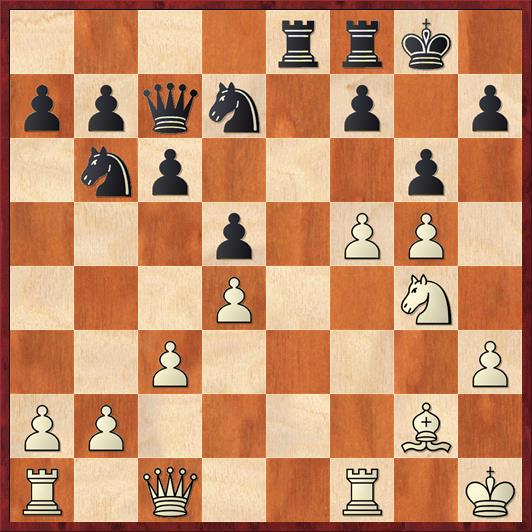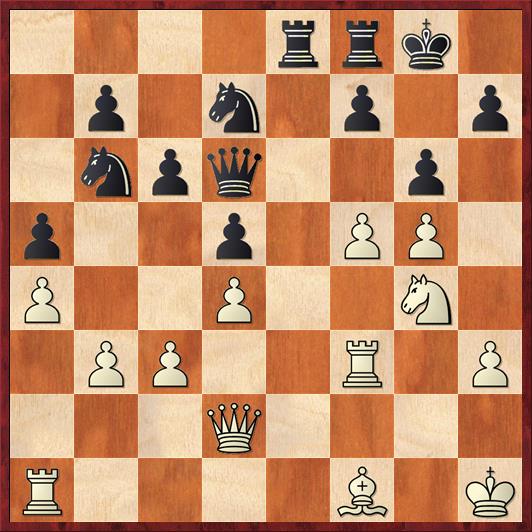I’ve been playing my computer a lot recently, in case you haven’t noticed. And if you have noticed, and you’re tired of seeing me write about meaningless games against my computer, I apologize. I alternate between thinking it’s a useful training method when I don’t have anyone else to play, and thinking it’s a complete waste of time that destroys my ability to play “real” chess against humans.
I could probably write a book now called “50 Ways to Beat Your Computer.” This game, which I played three days ago, would probably go in Chapter 1. The best way to beat your computer is… don’t let it do anything. Anything. Once you get it to a position where it can’t do anything, just sit and torture it.
Come to think about it, that is a great way to beat humans, too!
White: Dana Black: Shredder
 Position after 21. … Rae8. White to move.
Position after 21. … Rae8. White to move.
FEN: 4rrk1/ppqn1p1p/1np3p1/3p1PP1/3P2N1/2P4P/PP4B1/R1Q2R1K w – – 0 22
In this position I used my “Matrix chess” timeout. I think it was a really good time for a timeout, because it allowed me to steady my nerves and see what is going on. At first I thought that Black was seriously threatening 22. … Re2. But then I saw that after 23. Bf3 the knight is defending h2, so Black has no checkmates and the rook is obliged to retreat.
After I saw that, I started to come to the conclusion that Black has no substantive threats at all. For instance, if he ever tries to double rooks with … Re7 and … R8e8, then I can answer with Nf6+! If Black plays Nxf6, then the pawn recapture on f6 will simultaneously threaten the rook on e7 and checkmate via Qh6-g7.
Also, an important thing to realize about this position is that 22. Nf6+? right away is premature. Black can capture on f6 and then attack the f6 pawn more times than White can defend it. Also 22. f6? does not seem like the right idea, because it closes lines on the kingside instead of opening them. And 22. Nh6+ also seems kind of pointless.
From all this I concluded that this is a position where White can be patient (because Black isn’t threatening anything) and should be patient (because it’s too early to see what the breakthrough will be). If we’re going to be patient, then what should we do? Well, the number one thing is to invite all of our pieces to the party. My rook at a1 and bishop on g2 are both not participating in the attack. That’s one reason that immediate tactics don’t work. So I should work on freeing those pieces, with Qd2, Rf3, Bf1-d3, and Rf1. But before I do any of that, I should keep Black’s knight out of c4, so it won’t harass my queen and threaten to invade on e3.
22. b3 Qg3 23. Rf3 Qc7
A major decision for Black. 23. … Qh4 would probably enable him to defend his kingside more easily, but at a huge cost: The queen at h4 is completely hemmed in. Though it’s not clear that I can actually win the queen, the fact that it is paralyzed suggests that I should be able to make progress by breaking in the center or queenside. After 23. … Qh4 I should consider 24. f6 (to shut down the kingside), which two moves ago didn’t make much sense.
24. Qd2 a5 25. a4 …
Although it’s not clear that Black’s threat of … a4 was anything to worry about, this move is most consistent with the edict, “Don’t let the computer do anything.”
25. … Qd6 26. Bf1! …
Continuing to redeploy. The bishop will come to d3, from which square it will eye the kingside and be ready to come to the defense of the queenside pawns with Bc2.
 Position after 26. Bf1. Black to move.
Position after 26. Bf1. Black to move.
FEN: 4rrk1/1p1n1p1p/1npq2p1/p2p1PP1/P2P2N1/1PP2R1P/3Q4/R4B1K b – – 0 26
At this point the computer “cracks” and plays a very human-like move. Humans usually don’t like to sit and play rope-a-dope defense for a long time; they will usually lash out at some point. Computers are not emotional, though, so that is not not the explanation for Shredder’s next move. I can only think that Shredder (playing at about 2170 strength) calculated inaccurately.
26. … f6?
Suicidal, but what else can Black do? White is just going to continue turning up the pressure with Bd3, R1f1, Bc2, maybe even Qf2, maybe even a pawn march with h4-h5. I don’t have to commit myself to any plan of action; I have so many ways to make Black more uncomfortable and keep him guessing about where I will strike first.
Shredder’s hope, I think, is that it can open the position now before my pieces are completely mobilized. But it just doesn’t work.
27. Bd3 fg 28. Qxg5 …
With the huge threat of 29. fg. Shredder stops it the only way it can, but runs into another strong pawn move.
28. … Qe7 29. f6! …
 Position after 29. f6. Black to move.
Position after 29. f6. Black to move.
FEN: 4rrk1/1p1nq2p/1np2Pp1/p2p2Q1/P2P2N1/1PPB1R1P/8/R6K b – – 0 29
For all practical purposes the game is over. If 29. … Qf7 30. Nh6+. Otherwise, the threat of f7+ is decisive. For instance, if 29. … Qd8 30. f7+! Rxf7 31. Nh6+, or 30. … Kg7 31. fe8=N+, or 30. … Kh8 31. fe8=Q! Qxg5 32. Rxf8+. (Alternatively, 29. … Qd8 could be met by 30. Bxg6, which is even more straightforward. White’s position is so good that he has multiple ways to win.)
So instead Shredder chose to give away a piece with 29. … Nxf6 30. Nxf6+, but even that wasn’t enough. White must also win the exchange, because if 30. … Kh8 there is a sweet queen sac for a checkmate with 31. Nxe8 Qxg5 32. Rxf8 mate. When you see this sort of tactic, you know that the chess gods are on your side! Instead Shredder played 30. … Rxf6 31. Qxf6 Qxf6 32. Rxf6, but even though Black picked up a second pawn after 32. … Rf3, the endgame of two pawns against rook is hopeless, and I won about 30 moves later.
I really liked this game because it wasn’t “computer chess.” It was real chess in which one player happened to be a computer, and I was able to formulate a plan and execute it. It also showcases the more patient style of attack that I have been learning over the past few years thanks to the Mike Splane parties.


